
How to use SEO to add $4,500 in new revenue each month (from scratch)
Using the competitor research framework I’m about to show you, I’ve grown Docsketch (our new product) from nothing to 4,000 uniques a month:
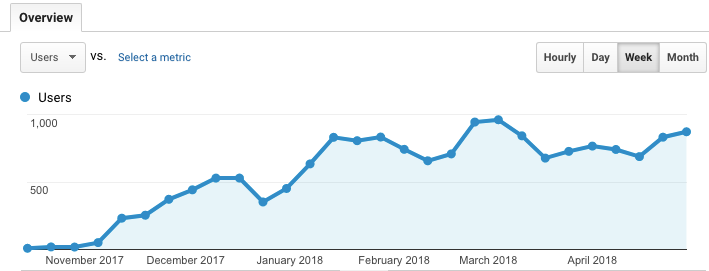
What you see above isn’t vanity traffic that fails to convert. No, we’re getting sustainable traffic that’s aligned with our electronic signature product that results in paying customers. We’re talking about $4,500 in new lifetime value revenue each and every month.
Here’s what the entire process looks like:
- Create a list of competitor sites
- Research competitor sites and find target keywords
- Prioritize your keyword list
- Pick the target keyword topic that’s easiest to promote
This approach isn’t magic, and it does take some patience, but it works. I’ve used it in the past at various stages marketing our first SaaS product (called Bidsketch), and I’m using it again with our new product.
Back then, using this strategy on Bidsketch, we increased new trials and customers by 30% and added 20,000 uniques a month in new traffic:

How the competitor framework works
When you’re starting out, you don’t have any existing visitors. So, any useful data is going to come from researching your competitors.
By “competitors,” I don’t mean direct competitors — instead, I’m referring to any site that competes for the same type of traffic. For most of this process, we’ll be using SimilarWeb, and Ahrefs, but there are many other tools that do the same job.
Here are a few great ones for this type of competitive research:
- KeywordKeg (best for lower budgets)
- KWFinder (recent favorite)
- Moz
- SEMrush
- BuzzSumo
We use tools like these to find out where sites are getting their traffic, what the potential traffic is for key phrases, and how competitive each topic or phrase is.
Who we’re targeting: A real-world example
Say I’m building a simple client booking app for photographers (a real world example I’m working on!). So, the audience I’ll be targeting is made up of photographers looking for a booking solution.
Since the app doesn’t have any visitors that we can talk to yet, we’re going to focus on competitors and see what’s working for them.
Again, this doesn’t mean direct competitors (other booking apps) — I mean anyone that’s getting the type of traffic I want to get. This could be a blog, podcast, YouTube channel, website for a camera manufacturer, and so on.
By looking at traffic competitors, instead of product competitors, we’re able to generate a lot more ideas based on things that are proven to work with our target audience.
So, let’s dig in.
Step 1: Find competitor sites
One of the easiest ways to get started is to Google “best [market] blogs.”
For my photography app, I search for “top photography blogs.” I can also search for “best tools for photographers,” and “best resources for photographers.” Normally, I’d go through many different categories of sites, but let’s keep things simple for this example and stick with blogs.
When I did that, I came up with results like this:

Digging through lists of blogs takes some work, but you’ll need to go through each one of these sites and see which blogs seem to be the industry leaders — any blog that gets mentioned repeatedly is a good target.
Generally, you want sites that get the most traffic. You can check traffic by using tools like SimilarWeb or Alexa, both of which allow you to check site traffic for free:
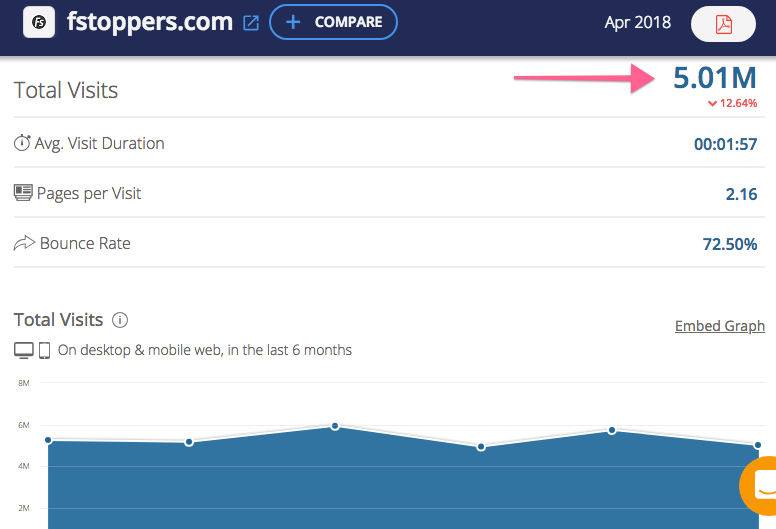
Just make sure you stick with a single tool when comparing sites. Estimates are not very accurate in these tools, but if you’re comparing sites to each other, they do a good job of letting you get a feel for which sites are more popular.
In my research, these sites were getting a lot of mentions:
- Fstoppers
- PetaPixel
- Light Stalking
Step 2: Research and find target phrases
Using Ahrefs I check to see the pages that get the most traffic for a site by clicking on the “Top Pages” section. We’re just trying to identify a list of the top keywords for each site. Many tools like SEMrush and SimilarWeb will also give you this data.
Going down the list, I spot a couple of interesting opportunities that I should research some more:
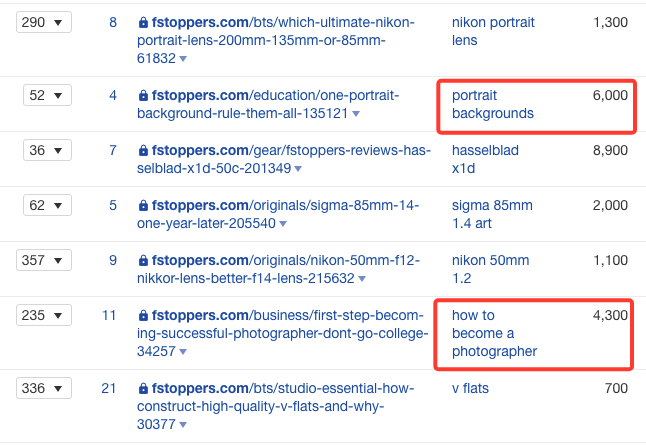
From here, I click on each target phrase and can see how competitive it is:
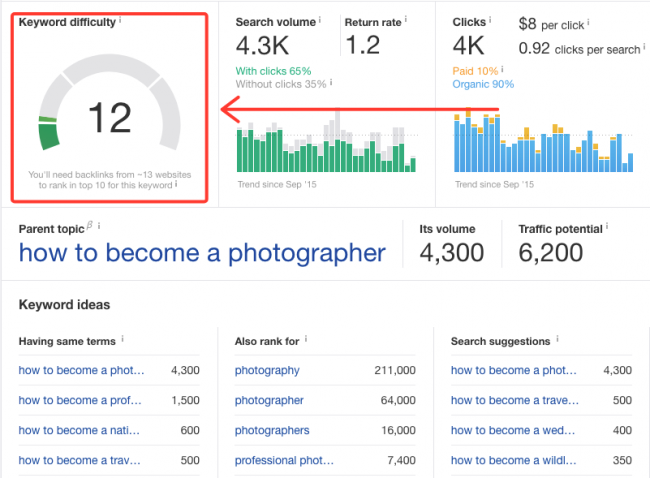
The keyword we’re looking at in this screenshot has a difficulty score of 12 out of 100. The lower the number the better. A score of 100 would be the most competitive keyword there is.
The more competitive a term, the more links your content will need. In this case, it says that you need 13 links to rank top 10 in Google for the “how to become a photographer” keyword.
Each tool has its own way of measuring competition, but I try to stick to phrases that have zero competition, or are just above that.
At this point, we’re looking for terms that get good traffic, have low competition, and are aligned with the product. This means:
- More than 200 monthly searches
- Low competition (difficulty score of 10 or less)
- The intent of the searcher tells me they can buy my product
Sometimes I’ll come across a target phrase like “How to become a photographer”: It has lots of monthly searches in Google (volume) but doesn’t meet my good keyword criteria for a couple of reasons:
- People searching for this phrase aren’t photographers yet, so very few will convert to my product
- The keyword is more competitive than I’d like (score of 12) considering these searchers aren’t photographers yet
But it’s close to what I want, so I click on related and suggested keywords that Ahrefs is showing at the bottom of that page:
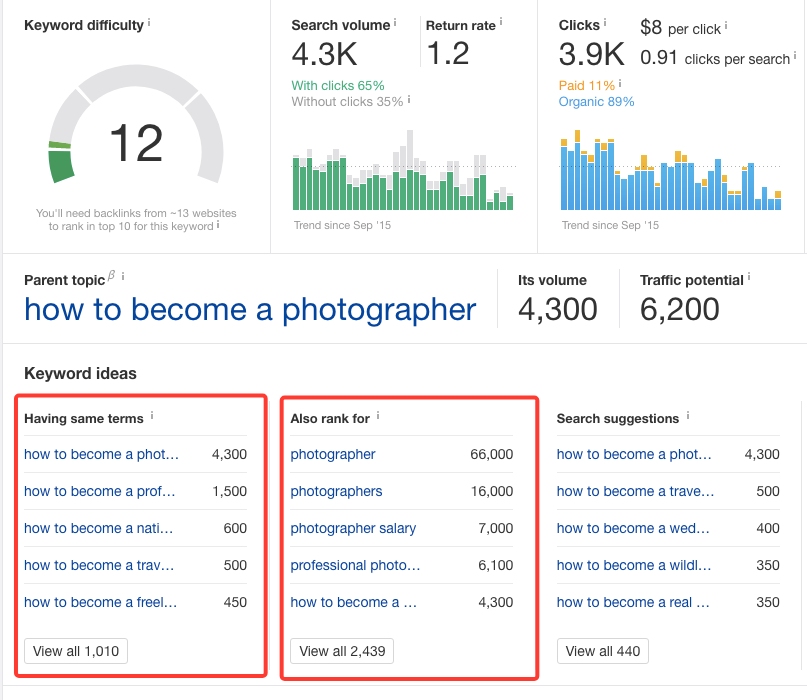
Almost all keyword tools have this feature. It’s a great way to find something that has enough traffic potential but isn’t too competitive for a less established site.
Clicking through one related keyword to another, the key phrase “how to become a photographer” eventually led me to “photography business names.” The new key phrase has a difficulty score of 1.
This was the entire path I took:
how to become a photographer -> how to get into photography -> how to start a photography business -> photography business names
The initial list of potential key phrases looks like this:
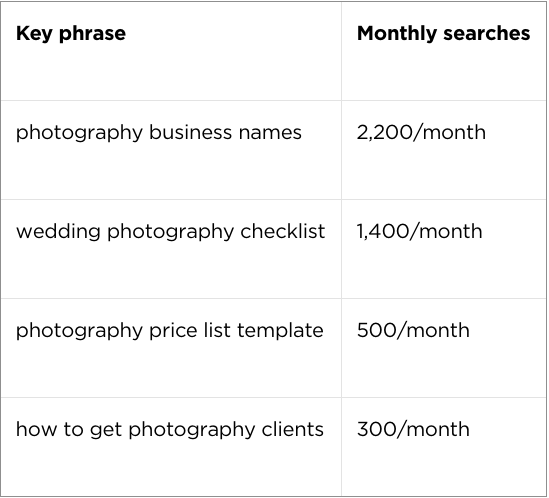
The more of these good keywords you can find, the better.
This is an important thing to keep in mind: Some phrases might get good traffic, but aren’t quite in line with what you’re offering. For example, a phrase like “model poses” gets a lot of traffic, but someone who’s searching for model poses is thinking more about the technical aspects of doing photography versus the business side. Because we want to eventually convert people to our photography booking app, we’re more interested in different types of search phrases.
Ready to improve your habits and level up your life? Download our FREE Ultimate Guide To Habits below.
Step 3: Prioritize the list
Next, we need to prioritize this list. For that, we’ll be looking at the following:
- Traffic that’s aligned with the product
- Very low competition
- The potential for an angle that makes sense and that we can promote
- High-quality, sustainable traffic
Again, in Ahrefs I go into the “Keywords Explorer” and sort each phrase by difficulty. The lower the number, the less competitive it is.
Here’s what I found:
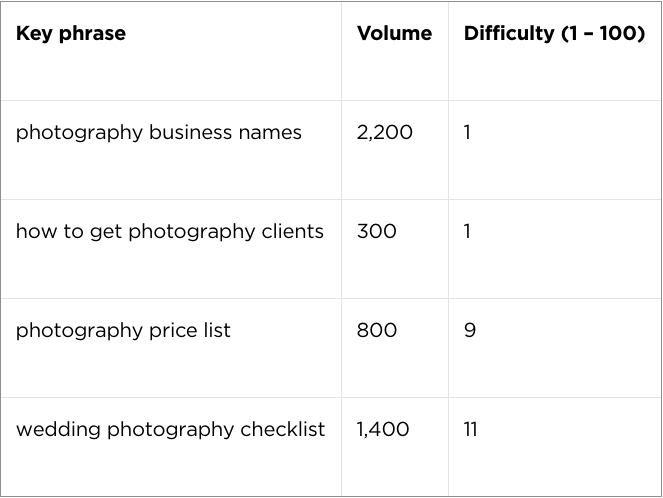
When doing this analysis, don’t just rely on the tools. Go to Google and search for these terms to see what the actual intent is.
For example, searching for “photography price list,” I can see that it’s probably photographers looking to find out ways to present their services and prices. If you change the keyword slightly to “photography prices,” you end up with completely different intent: people wanting to know how much photographers cost.
This helps inform what type of content to create, and helps me figure out the promotion strategy.
Step 4: Set yourself up for success
Next, I take the top three keywords that I’ve narrowed down, and think about which one we could create content around that’s easiest to promote. There aren’t any tools that make this part easier, but here are a couple of tricks I use to figure this out.
To start, search Q&A sites like Quora for that phrase.
I do this by going to Google and typing the following: site:quora.com photography pricing.
As you’ll see, there are lots of results!

Quora gets over 100 million visits a month and answering questions there is a good way to get some of those visitors to click through to your site.
You can search for different variations of this phrase — for example, photography rate, charge, and so on.
Pricing is a very popular topic across almost any industry, so I’m not surprised it’s the easiest to promote on the list.
I also think to myself the following questions:
- Would this be something I can run Facebook ads for?
- If I guest post for someone, is it likely to be something I reference?
- Would people be interested in a guide, checklist, or e-book related to this?
Step 5: Creating and promoting the content
This framework is a great way to uncover big marketing opportunities, but you still have to actually create and promote your content. You typically want to pick a single phrase, spend a week on content creation, and plan to spend several weeks promoting the content.
Why should you spend so much more time promoting the content?
Because at this point:
- You’ve done all the research and know the potential traffic for your keyword topic
- It’s clear this traffic is likely to convert into paying customers
- You know that you can compete for the traffic because it’s not competitive
However, just because you’ve estimated that you’ll get a good amount of traffic doesn’t mean you can do a sloppy job of creating the content. Focus on the people reading your content and try to create something that will genuinely help them (here’s the process GrowthLab uses).
Here’s a simple framework for doing that:
- Analyze the top five pages that show up in Google for your target keyword
- Write down each of the major subtopics that they cover (if you think they all add value)
- Create a post covering every single subtopic and add an additional subtopic or unique angle, to make sure that your content adds something extra that readers won’t get anywhere else
Now that you have the content, you have to plan out the promotion of that content.
Even though we’re targeting traffic from Google, your promotion strategy shouldn’t depend solely on you ranking highly for that phrase. You also want to go after referral traffic: traffic from sites other than Google.
You can do this by doing some of the following (and including a mention of your content):
- Answer questions on Q&A sites like Quora related to your topic
- Contribute great comments in related forum questions
- Set up a Google Alert notification for your key phrase, and comment on posts or answer questions related to this
- Run Facebook ads to your content (which is much cheaper than trying to run ads to products directly)
- Pitch guest posts related to your topic on appropriate websites and blogs (here’s a great resource on how to guest post from a freelance journalist and guest posting expert)
There’s obviously a lot more you can do to promote your content, but even this small list should keep you busy.
There are great things that happen when you take this approach. First, Google sees all of these signals referencing your content and it helps you show up as a top result eventually. Second, organic traffic takes time (months usually), so in the short term, you’ll receive traffic from other sites besides Google.
Wrapping up
While it can seem challenging to start marketing your business when you don’t have an existing audience, if you follow this process, you’ll be off to a good start.
As I mentioned before, it took us a few months to start getting more traffic and customers. This process is not a quick fix but it works, and it’s a great way to build a steady stream of new customers.
The more you do it, the more you’ll be able to both grow your audience while simultaneously tweaking your strategy for choosing keywords and creating content around them. Plus, you’ll continue to learn more about your target audience, which will help you with your product and marketing.



